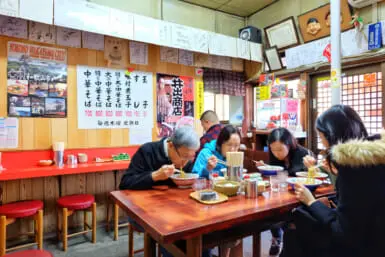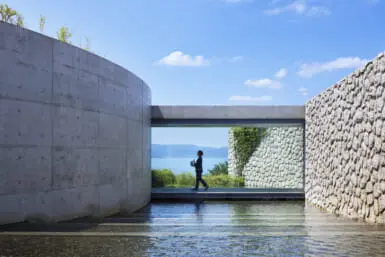Christine Cunanan-Miki savors this Shanghai surprise
The first thing that strikes you about China Blue is its beautiful decor, which mixes modern and traditional in a way that is stunningly grand but also romantically cozy. True to its name, a 7.4 meter vermillion blue gate stands at the entrance and giant Prussian blue-colored lanterns dangle from the two-storey ceiling, setting the tone for an avant-garde atmosphere that is part “Last Emperor” and part high-tech 21st century.
Meanwhile the food is best described as cutting-edge traditional Chinese, although happily it is not nouvelle cuisine or fusion. It’s got all the familiar tastes of everyone’s favorite dishes, but none of the heaviness or starchiness. It’s delicious Chinese food that tastes different enough that you instantly know you’ll be back for more.
My husband and I began our meal with Peking duck, and China Blue’s version is light on the hoisin sauce, with a hefty piece of salty duck meat wedged in between the spring onions, fried pastry strips (for extra crunchiness) and wrapper. This enabled us to actually taste the meat and to savor its saltiness along with the sweet sauce rather than to try and wade through the myriad of flavors usually associated with this dish. Next we ordered the shark’s fin soup with scallops, and trays arrived bearing teapots filled with broth and bowls of incredibly fresh scallops, enoki mushrooms and shark’s fin. We joyously poured the pungent broth into the bowls and relished the aromatic dish the combination of piping hot soup and juicy pieces of seafood instantly created. At ¥7,000 per order, though, China Blue’s shark’s fin soup — which comes in different versions, including one with salmon and another with vegetables — is obviously not something one orders without thinking twice. However, practically every table around us was paying up for a bowl.
For a seafood entree, our waiter recommended the steamed fish with ginger and spring onions, which he said was one of the restaurant’s most popular dishes. “This is the one item that our regular customers keep ordering again and again,” he explained. After such an introduction, of course we had to have it, and we certainly were not disappointed. A perfectly steamed and incredibly tender fillet of white fish arrived, lying on a shallow pool of forest green sauce that reeked of ginger and provided the perfect punch to a dish otherwise full of smooth finesse. The fish itself had little taste (this was what the sauce was for), but its lightness and fleshy consistency, and the way each piece swished around in the mouth, was pure pleasure.
Finally, as if to balance out all the refined flavors we had been enjoying so far, our meat entree, a fatty rib-eye with white mushrooms and sliced red onions, roared out of the kitchen with enough Oriental spiciness to wake a sleeping dragon. This fiery Chinese-style steak, which looked like it had been pan-fried in a wok, is certainly a great take on a favorite — my normally spice-averse husband finished his entire order and a significant portion of mine as well.
China Blue’s chef, Albert Tse, carved his reputation at Singapore’s famous Jiang-Na Chun restaurant before moving to Tokyo. Although we didn’t meet him, we were told that he aims to constantly create delicious dishes that are traditional yet so original you won’t find them anywhere else. Well, with such a cooking philosophy, I’m certainly glad that he’s decided to call Tokyo home for now.
WHAT TO EAT
For starters, we loved China Blue’s Peking Duck (¥2,000 per piece) and various sharks’ fin soups (¥7,000 per order). For the main course, the most popular items on the menu are the steamed fish with minced ginger and spring onions (¥2,300) and the Oriental-style stir-fried rib-eye steak (¥3,400). End your meal with the Ying Yang fried rice with shredded abalone (¥1,500), another specialty, and a beautifully presented mousse made of Philippine mangoes (¥1,200). There is also a healthy menu offering options like steamed egg white and fresh scallops (¥2,800) and braised sliced abalone with spinach bean curd (¥4,000).
WHAT TO DRINK
Chinese rice wine is most appropriate, vintages (ranging from eight to ten to 20 year old) of Koetsu-Ryuzan Chien Nian Chiew liquor are available (from ¥1,500 for a 160 ml eight-year wine to ¥35,000 yen for 500 ml 25-year wine). However, for those who must have some other kind of wine with their meal, China Blue has a floor-to-ceiling wine cellar on display with over 3,000 bot-tles. Among these, we found a decently priced Chilean Chardon-nay called Casa Lapostolle (¥1,950 per glass) that went well with almost everything we ordered.
WHERE TO SIT
The most coveted tables are window-side with views of Tokyo Bay and the Hamarikyu Gardens. But I personally prefer one of the sea-green colored banquette tables lined up against the wall that enable you to fully appreciate this gorgeous restaurant.
HOW MUCH DID IT COST
Plan on spending at least ¥30,000-¥40,000 for dinner and drinks for two.
WHO GOES THERE
We went on a Saturday night and the restaurant was 2/3 full, with an even number of couples on dates and families with small (children, which was surprising considering the elegant and rather pricey atmosphere. However the young families all seemed to be enjoying themselves.
WHO TO ASK FOR
The restaurant manager’s name is Kiyoki Yoshioka, and Hamdy, a friendly bilingual waiter from the Maldives, will be happy to discuss everything from your food options to football.
CHINA BLUE
Conrad Tokyo, 1-9-1 Higashi Shinbashi, Minato-ku, Tokyo
Tel. (03) 6388-8000.
www.conradtokyo.co.jp









